I was listening to a testimonial from one of our long-term customers, who’s been using our ticketing software for over 10 years. Her story was very relatable…and I bet you share the same sentiment.
Her business at the time was using Google Workspace for its customer support needs. The service team faced hurdles like:
- The inability to track and follow up on customer tickets when team members were out of the office, due to multiple support addresses and no true shared inbox.
- Lack of a knowledge base that could be integrated into support conversations. This made it difficult for the team to have clear communication and deliver a strong customer experience.
Overall, Google Workspace just didn’t provide the productivity and efficiency improvements the business needed to support its customers.
If that sound relatable, it’s because most small businesses face similar challenges with email clients. At the end of the day, we all want a solution that solves problems, rather than creating them.
So this customer stumbled upon our help desk solution, and found Groove to be a
robust platform that’s easy to use and easy to customize
Let’s talk about how you can do the same – use ticketing software to increase customer satisfaction for your small business, while saving time and effort.
Why Ditch Email for Ticketing Software?
Relying solely on email for customer support is straightforward enough. But it often leads to a tangled web of messages, making it hard to manage support requests.
Help desk software streamlines the process by putting all your customer interactions in one place. Your team can access and respond to inquiries from a unified dashboard. No one will have to worry about messages getting overlooked, or waste time switching back and forth between addresses/platforms.
When used for small business support, ticketing software prevents costly issues like:
- Lost emails. Important customer messages can easily disappear in a busy inbox, leading to missed opportunities and unresolved issues. Then you get reviews like this.
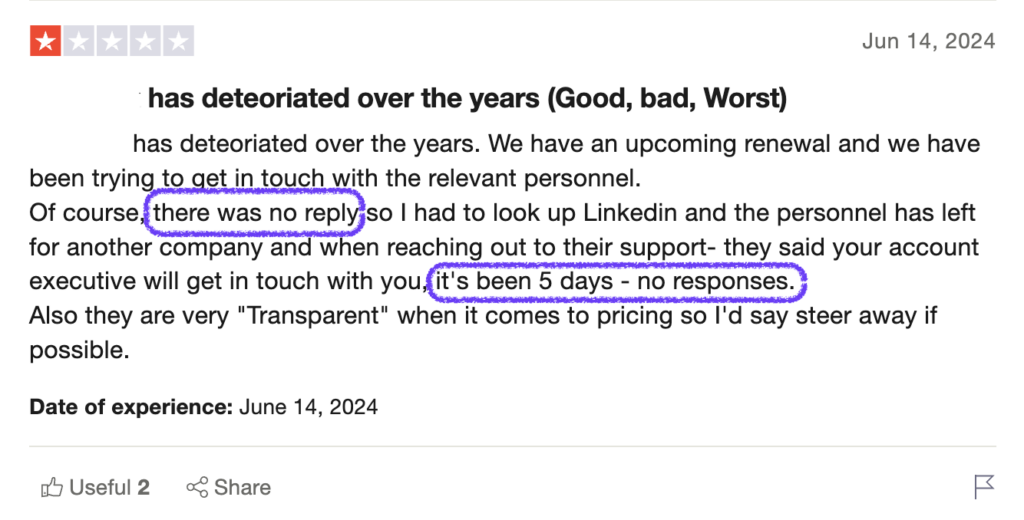
- Slow response times. Manually handling each email can be time-consuming, resulting in delayed replies that frustrate customers.
- Inconsistent support. When you have varying responses from different team members, it’s easy to have an uneven customer experience. This makes it hard to maintain quality standards.
- Difficulty tracking customer history. Without a structured system, it’s hard to keep track of past interactions with customers and understand their needs.
- Lack of reporting and insights. Email alone doesn’t provide the tools needed to analyze support performance, identify trends, and make informed improvements.
Transitioning to a quality help desk solution addresses these challenges. This kind of software includes features that give you a structured, efficient, and scalable solution for managing customer support.
The Benefits of Using Ticketing Software
Now let’s get a little more positive! We know what the challenges of the old approach are. What are the benefits a help desk can bring to your customer service team?
You can expect:
- Centralized communication. All your customer interactions – whether through email, chat, or social media – are consolidated into a single, unified inbox. Also, your support agents have a complete view of each customer’s history.
- Improved response times and efficiency. Streamline your support processes by automating tasks like tagging and routing incoming requests, and sending instant acknowledgments and pre-written responses for common questions.
- Enhanced customer satisfaction. Ticketing software enables proactive support by allowing you to anticipate customer needs and address them more effectively. When done right, this leads to higher customer satisfaction and increased loyalty.
- Data-driven insights. Quality ticketing software provides comprehensive data on KPIs like response times, resolution rates, and customer satisfaction scores. These insights help you identify trends and pinpoint areas for improvement.
- Team collaboration. A dedicated help desk platform ensures that everyone on your support team can access and manage customer conversations seamlessly. This ensures better collaboration, prevents duplicated efforts, and maintains consistency in support responses.
- Scalability. Some ticket management software can scale alongside your business. This allows you to handle an increasing volume of customer inquiries without compromising on quality.
Must-Have Ticketing Features for Small Business Success
There’s a lot of ticketing software out there. Which one is right for your small business?
Only you can answer that question in full. But to get you started, here are some of the most essential features.
Ease of Use and Implementation
When time and resources are short, look for a solution that’s quick to set up and user-friendly. You shouldn’t need an IT team to configure your small business ticketing software.
An intuitive interface, clear documentation, and seamless integrations ensure minimal training time. That means minimal disruption to your business and customers during the switch. It also means you’ll be able to benefit from the new features and options immediately.
Robust Ticketing System
A quality ticketing system automatically logs each customer request as a ‘ticket’. This happens regardless of where the inquiry came from (email, social media, live chat, etc.).
With everything in one place and formatted the same way, you can track, categorize, prioritize, and manage inquiries efficiently. Messages won’t slip through the cracks, and every customer issue receives the proper attention.
Automation Capabilities
Maximizing a small support team means taking as many rote tasks off their plates as possible. Look for ticketing software that can handle repetitive work like:
- Sending acknowledgments
- Routing tickets to the appropriate team members
- Triggering predefined responses for common questions
When you automate these processes, your team can focus on more complex issues and provide proactive customer care.
Self-Service Options
Empowering customers to find answers on their own through self-service options cuts down the volume of support tickets. One common approach is to create a comprehensive knowledge base with FAQs and helpful articles.
This resource lets customers resolve issues without needing your support team. Many buyers like it when they can handle problems on their own. It’s a win-win situation, because you improve customer satisfaction by providing instant solutions while also putting less strain on your team.
Reporting and Analytics
Data-driven insights are important, especially when you care about optimizing your support strategy. Quality ticketing software provides reporting and analytics features that help you keep track of key metrics.
These insights allow you to make informed decisions and improvements. It’s especially beneficial if these metrics are tracked automatically and displayed in a user-friendly way, so you don’t have to be an analytics expert to understand them.
Essential Integrations
You want a system that can work with your existing tools, right? Otherwise, you may have to resort to doing more tasks manually.
Whether it’s your CRM, e-commerce platform, or project management tool, your help desk should be able to connect effortlessly. This is also useful for efficient data management.
Mobile Accessibility
The ability to manage customer support on the go is priceless. Don’t you agree?
With that capability, small businesses can provide timely assistance to customers no matter where team members are. So when choosing ticketing software, it’s best to opt for one with a dedicated mobile app.
Reliable Vendor Support
Last but not least, it’s important to choose a vendor that offers prompt and helpful customer service, along with comprehensive resources like tutorials and FAQs.
After all, you need support sometimes too! When issues arise, you’ll want multiple ways to get help fast, via whatever channels or methods your team prefers.
How Groove Transforms Customer Support for Small Teams
There are plenty of great help desks out there. Each is ideal for a particular type of user. The challenge is to find the right fit.
Our own ticketing software, Groove, is built for small businesses that need a user-friendly tool they can depend on. If you’ve never tried a help desk before, and if you’re working with a small team and tight resources, it provides a balanced mix of functionality, ease of use, and affordability.
Is it right for your business? The best way to decide that is to get some hands-on experience – that’s why we offer a no-strings-attached free trial.
We encourage you to check it out! Meanwhile, here are some of the benefits Groove brings to the table.
Ease of Use and Implementation
First up, Groove offers an intuitive interface and a straightforward setup process. It’s designed to feel instantly familiar if you’ve used any traditional email client like Gmail or Outlook.

Your team can get up and running in minutes, thanks to guided onboarding and key features that are easy to locate.
You also get seamless integrations with many popular tools, which allow you to maintain your existing workflows without disruption. These are all just as quick and simple to set up.
Robust Ticketing System
Groove’s ticketing system enables an organized and efficient workflow. Every incoming customer request (no matter where it originates from) is automatically converted into a ticket in your shared inbox.
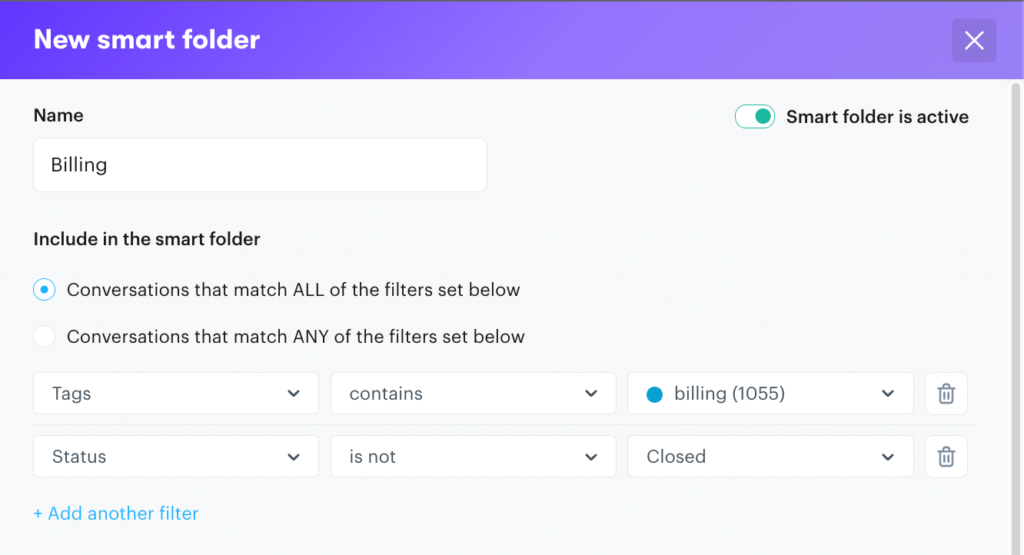
This lets you track, prioritize, and manage inquiries with ease. When combined with customizable ticket statuses and workflows, your support processes can align perfectly with your business’ needs and your team’s preferences.
Automation Capabilities
Groove’s automation features streamline repetitive tasks and enhance team efficiency. You can automate responses for common customer queries, and route tickets to specific team members based on capabilities or workloads.
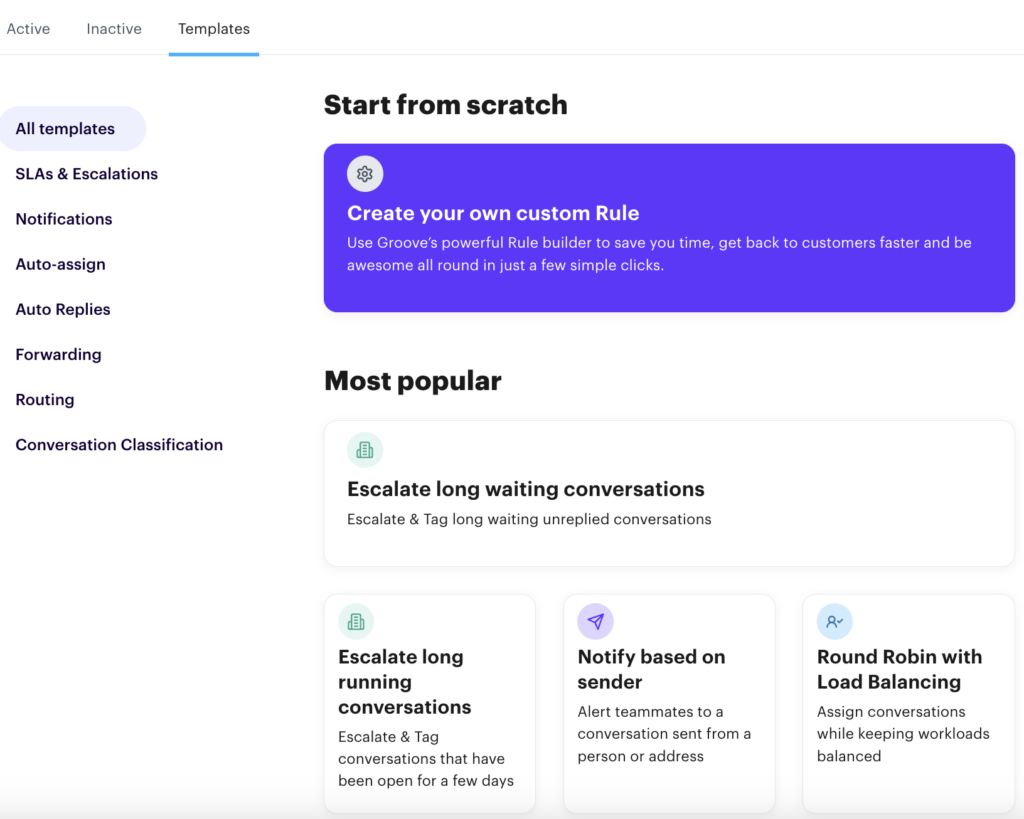
You can also schedule follow-up reminders effortlessly. Some tasks need a human touch – others are better automated once, and then left to run on their own.
Reporting and Analytics
One of the features you’re least likely to get from traditional email platforms is reporting functionality. With Groove, you don’t need a third-party tool or special analytics knowledge. Key support KPIs like response times and resolution rates are automatically tracked and displayed in clear, visual way.

This data provides valuable insights into your support performance. You can view team-wide stats and individual agent performance metrics – both are vital for providing the best possible service quality.
And More…
What else does Groove offer for your small business support team? Here are a few other features you might be interested in:
- Self-Service Options. Built-in knowledge base functionality lets you create a self-service resource for your customers. You don’t have to do any technical work at all. Just write up the articles, add a link somewhere prominent on your website, and you’re good to go.
- Essential Integrations. We’ve curated a list of popular tools that are highly valuable for customer service teams. Whether you use these platforms now or plan to in the future, you can connect them up to Groove with minimal effort.
- Mobile Accessibility. To provide your team with the most possible options, Groove includes a dedicated mobile app. This tool allows agents to access and respond to urgent customer inquiries anywhere, any time, whether they’re Android or iOS users.
- Reliable Vendor Support. Our dedicated support team is available to assist with any issues or questions you might have. If you’re so inclined, you can also check out our comprehensive knowledge base, which empowers your team to leverage Groove’s full potential.
Groove Quick Wins: How To Get Started in Minutes and See Results Fast
Once you’ve signed up for Groove, it’s easy for your team to get started. Here’s what we suggest doing first, especially if your small business is new to ticketing software.
1. Complete Your Profile
Begin by personalizing your Groove account, under Settings > Personal:
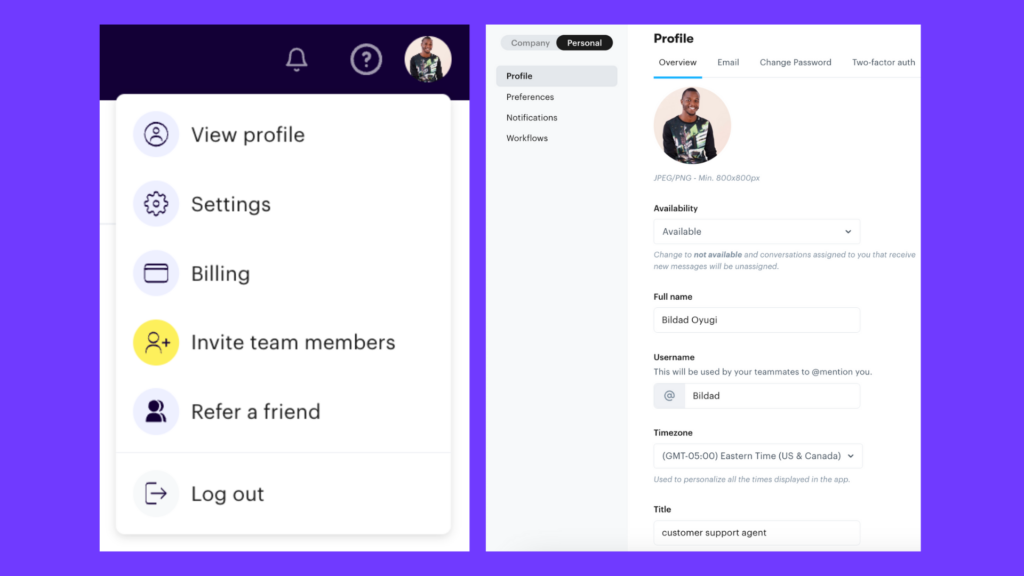
Here you can fill out your profile information, and set your notification preferences. Each of your team members can do the same (once you’ve given them access).
2. Explore the Conversations Inbox
Next, go to the Conversations section located in the top navigation bar. This will be your centralized hub for managing all customer interactions:

This is a good time to familiarize yourself with the layout:
- Navigation Bar. Access Conversations, Reports, Knowledge Base, Apps, and Settings.
- Inboxes and Smart Folders. Organize your support requests by customizing the default Smart Folders, or creating new ones to suit your business needs.
- Main Inbox View. View all your conversations in one place, making it easy to manage and prioritize customer inquiries.
3. Set Up Live Chat
If your business engages with customers through live chat, we’ve made it easy to integrate this directly into your support system.
Go to Settings > Widgets to enable and configure chat functionalities. Then you’ll want to select Create New Widget > Live Chat:

After that, you can customize the live chat feature to match your preferences.
4. Configure Key Automations
We highly recommend streamlining your support process by setting up automated responses for frequently asked questions. We call those “Instant Replies”.
You can create and manage canned responses for common questions by heading over to Settings and clicking on Instant Replies:
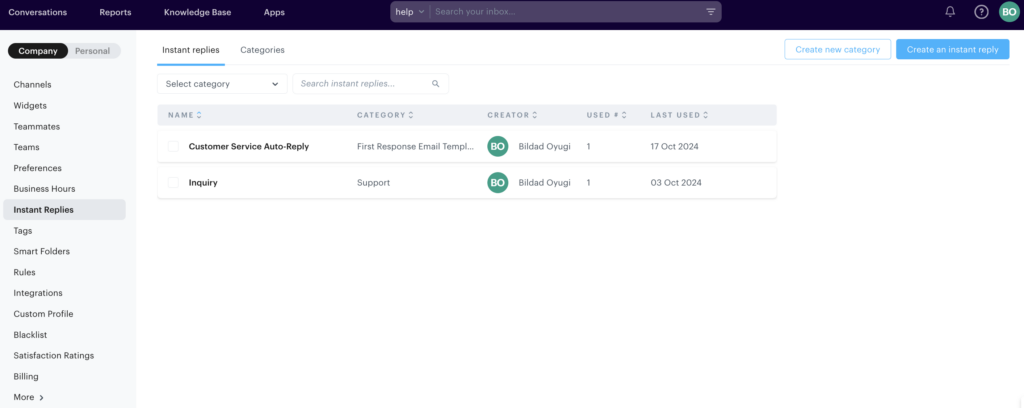
You can also configure Groove to automatically tag incoming inquiries, and route them to the appropriate folders and team members. To do this, click on Settings and select Rules:
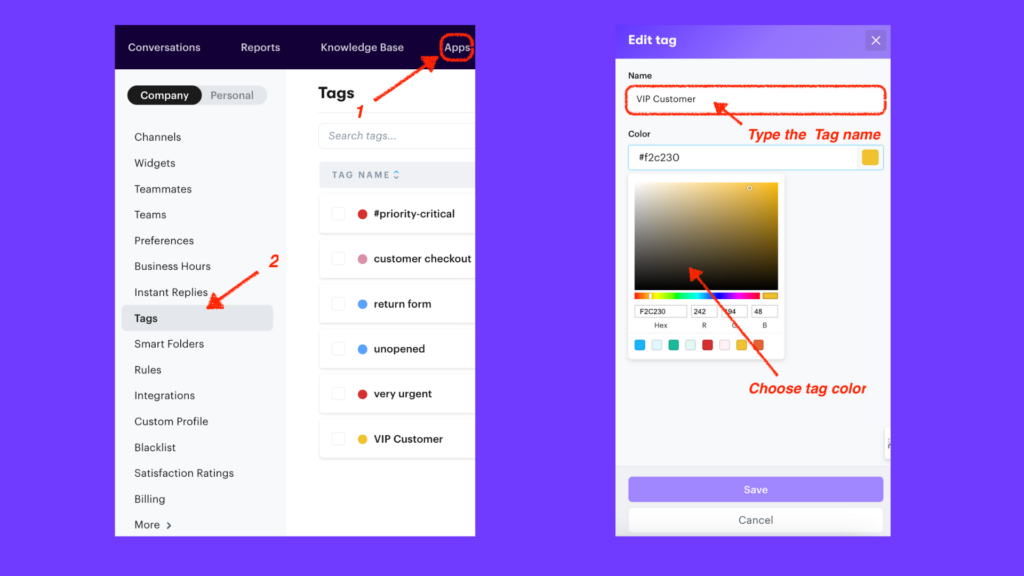
There are all kinds of rules you can set up. Taking the time to do this upfront starts your improved support experience off on the right foot.
5. Build Your Knowledge Base
To create create self-service resources, head over to Knowledge Base > Create Article:
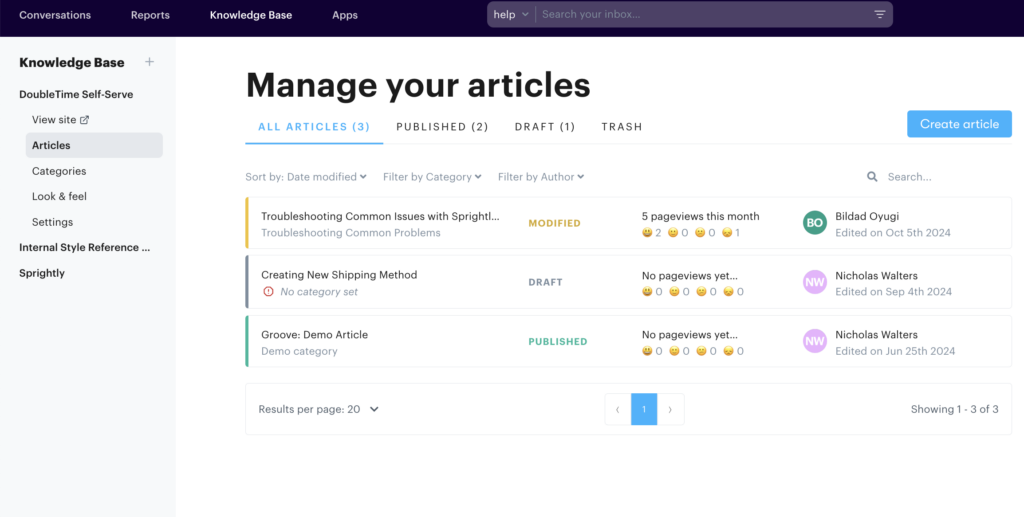
You can use this feature to add informative articles and frequently asked questions. Then you can structure your knowledge base for easy navigation via categories.
The resources you create will be live by default – you just have to point customers in the right direction. You can also use the Knowledge Base search bar within the reply section of any conversation, and insert relevant articles right into your responses.
Transform Your Small Business with Ticketing Software
Investing in help desk software is a game-changer for both your team and your customers. It streamlines workflows, enhances team efficiency, and leads to happier, more loyal buyers.
Even simple steps, like setting up automated responses and creating a basic knowledge base, can make a significant difference in how your support team operates and how satisfied your customers feel.
Ready to transform your customer support? Don’t let chaotic email management hold you back – get started with a free trial today!





